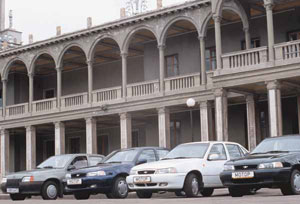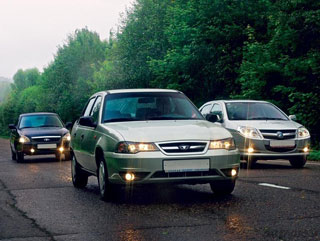Daewoo Nexia (Kletn) 1995 test drive - NV sedan
"Nexia" can be trusted
The author from Kazan, the candidate of technical sciences, the creator and director of the service center of the company Acos, one of the largest dealers in the Volga region - analyzes the experience of operating these cars.The buyer should know that there are Korean Nexia, produced at the FAU factories in Inchaon or Chanvone, Rostov, collected by Red Aksai from Korean components, and recently also from the components of the ROEU (Romania) factory, and Uzbek, manufactured by the UZDZAAVTO SP in Asaka. Differences in the appearance and configuration of cars are insignificant. Currently, Nexia is not produced in Korea, Red Aksai has also stopped their assembly, so you can only buy Uzbek Nexia with a new one.
Naturally, the first Nexia from Korea appeared in Russia, and in a special performance - without lambda -zond and a catalytic neutralizer, with reinforced shock absorbers and suspension springs, as well as other, not so significant changes.
The first impression of the car creates, of course, the body. The gaps between the elements are small, uniform. True, the Korean cars were a little better, more stable, and the quality of the color was higher. Rust appears only in those places where the coating of metal (scratches, chips, etc.) is damaged. But even in these cases, corrosion does not spread under the paint in the form of spiders, it is easy to eliminate with some kind of plant killer. In our experience, no additional measures for anti -corrosion treatment of Nexia do not need. True, in Kazan on the streets in winter they do not pour as much chemistry as in Moscow ...
Let us pay attention to one feature of the body of Nexia. The nodes of the doors hitch are made unregulated: one half of the loop is welded to the body rack, and the other to the door. Replacing the door on the Korean car is not a job, but a pleasure: I inserted the pins in the hinges, and that’s it. The door is in place, the gaps are 4 mm. This does not work with the Uzbek doors, you have to drive the loops (you guess what?). But this is the problem of the service, the client in any case will receive a car without flaws.
The engine deserves praises - it is well suited for operation in our conditions. The degree of compression is 8.6, in principle, even allows the use of A-76 gasoline (AI-83 according to the research method), but for this, using a special chip, it is necessary to reconfigure the ECU ignition program. There are four such programs: for AI-83, AI-87, AI-91, AI-95. The declared dynamic and economic characteristics of the car are implemented on gasoline and, accordingly, the AI-95 program. But for universality and omnivorousness you have to pay with efficiency. Different numbers are found in the literature, but in practice for Nexia on AI-91 gasoline (the most common option), average data on fuel consumption are as follows: on the highway at 90-100 km/h-6.5-7 l/100 km; in the city in the summer, without air conditioning - 8-8.5 l; There in the same winter - 9-9.5 liters. Driving style can either be slightly reduced, or significantly increased fuel consumption.
The state of nozzles significantly affects efficiency. They need to be taken care of. We recommend using a water supplier - monthly, the injector cleaner - after 5 thousand km, the intake valves and combustion chambers - after 10 thousand km. It is seriously necessary to relate to the change of oil. The period indicated in the instructions is 10 thousand km - the limit for good oil with quality in the API not lower than SH. For difficult operating and API SF oil conditions, the instruction instructs to change the oil after 5 thousand km. Failure to comply with the replacement periods primarily affects the performance of the hydraulic compensators of the gaps of the valve mechanism. First, a characteristic valve knock appears, and there, even before the replacement of the camshaft, not far from.
This engine has three traditional disadvantages. The first is the seeping of the oil due to the gasket of the valve cover. The disadvantage is also inherent in Opel with similar engines, it is useless to fight it - come to terms. The second - only for Uzbek machines - the leak of the antifreeze through the oil pump oil pump. The manufacturer knows about this defect, but in such cases leading firms in such cases conduct campaigns on the recall of defective units. The third drawback is also manifested only in Uzbek Nex. Some cars stop starting in winter when changing the weather. The reason is the lack of a spark. She appears as unexpectedly as she disappears. It is very difficult to catch this malfunction - the car comes to us, but yesterday .... Now, it seems to me that we have defect this defect, alas, without any help of the plant. However, this is a separate (and not short) story.
The gearbox of the Opel structure has been made since time immemorial - it is unpretentious and reliable. It is only necessary to monitor the level of oil and, if necessary, add it, preventing the work at a reduced level, otherwise you will have to change the needle bearing of the fifth gear. The clutch Carter since 1997 has been deprived of a technological hatch through which it was so convenient to diagnose and change the clutch nodes. Alas, this is a tribute to the struggle for the silence in the cabin of the car. A soft aching sound with uniform movement in the fourth or fifth gear has disappeared, but if you need to replace the clutch disc, remove the box. However, the disk serves more than 100 thousand km.
It is known: the drives of the leading shafts are in order while the covers are intact. Until 1997, both internal and outer covers were rubber, and now the outer covers were plastic. On rubber details, the cracks appeared at 70 thousand km - they were changed, and at the same time they examined the hinge itself and laid fresh grease. The plastic cover always looks like new, so it is difficult to determine the condition of the hinge. Sometimes water falls under the case through microne Executions, and the hinge fails. In general, once every 70 thousand km, you need to look under the plastic cover and change the lubricant.
The suspension is simple, quite reliable and repairing. I will give the average values \u200b\u200bof the resource of its elements: the ball support of the lever - more than 200 thousand km; The front silent block of the lever is more than 200 thousand km; The back of the lever is 90-100 thousand km; bushings of the reptile stabilizer - 90-100 thousand km; front shock absorber - 30 thousand km; The rear shock absorber is 50 thousand km.
The springs, front and rear, sometimes break, but not for those who travel quickly, but for those who fly low.
Diagnostics and repair of the front suspension (with the rear there are no problems at all, except for the springs) are quite simple, especially in cars from Uzbekistan, in which the ball support is attached to the lever with three bolts, and not rivets, as in Korean non -nims. But for simplicity and reliability, you have to pay discomfort on irregularities such as a washing board. Only modern and expensive pendants successfully cope with such an expensive.
The steering requires close attention. Firstly, the design of the re-mechanism (with or without hydraulic power steering) does not provide for the adjustment of the backlash in the engagement, according to the instructions, it is laid only during the repair, on the unit removed from the car. However, when it is impossible, but it is very necessary ... In general, we carry out adjustment using two special cods and a tricky sharpened installation. If you run the backlash, there is an increased wear of the rail and a tied knock, which cannot be eliminated by adjustment.
Secondly, the skew of the steering shaft is very annoying when assembling the steering column at the Uzdeu factory, which is accompanied by violins and screeching when rotating the steering wheel. Korean cars did not have this. We adjust the speakers either with pre -sale preparation, or at the first, free for the owner of the then. It leaves much to be desired by the quality of the tips of steering rods: as a rule, they barely reach 30 thousand km, although there are long -livers.
Nexia brakes are good. Since 1996, they put ventilated front brake discs. The branded pads live 40 thousand km in front and more than 100 thousand km from behind.
What to pay attention to? First of all, on uniform wear of the front pads. If one of them is thicker than the other, then it is time to restore the mobility of the caliper on the guides. This usually implies cleaning and lubrication, but sometimes you have to replace defective sealing elements. With an independent replacement of the front pads, do not forget to put the anti -script plates, otherwise you will be like a nine in front of the traffic light. The instruction prescribes to change the brake fluid after 30 thousand km or after 24 months. Change without hesitation. Brakes are too serious to save on them.
Electrical equipment works mainly reliably. True, the bearings of the generator are frankly weak. Less rarely lives up to 50 thousand km. A little longer than a century and the second. There are defects of voltage regulators, but most often in the warranty period, so the owner does not carry material losses.
That, perhaps, is all, in short. In Kazan there is Nexia with a mileage for two hundred thousand. And in Rostov-on-Don, Korean women work in the police and in a taxi. I emphasize: we managed to recruit this statistics, and the described nodes have been going through for a long time due to the fact that we organized the service and users strictly adhere to its regulations. The legends that a foreign car can not be looked at the hood of a foreign car to Nexia do not apply. I'm sure Mercedes too ...
The breakdown of the spring in the rear suspension (on the right) occurred in editorial Nexia during a run of about 30 thousand km.
Vladimir Demidov
Source: The magazine "Driving"
Daewoo Nexia (Kletn) 1995 - NV Daewoo
Daewoo Nexia (Kletn) 1995 - NV
Daewoo Nexia malfunctions: Detailed information| Nexia (Kletn) 1995 - HB | |
|---|---|
| Engine |  |
| Transmission |  |
| Control system and suspension |  |
| Brake system |  |
| Air heating and air conditioning |  |
| Launch and charging system |  |
| Electric components and so on |  |
| Corrosion body stability |  |

_1995_-_nv_10.jpg)
_1995_-_nv_11.jpg)
_1995_-_nv_12.jpg)
_1995_-_nv_13.jpg)
_1995_-_nv_14.jpg)


